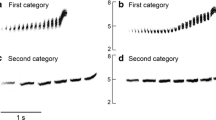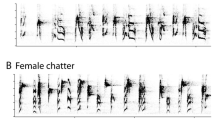Abstract
We examined the relationship between song performance and courtship success in the lek-mating long-tailed manakin (Chiroxiphia linearis) of Costa Rica. Teams of male manakins form cooperative partnerships consisting of a dominant alpha male and a beta male partner with a variable number of subordinate affiliates. Each alpha and beta partnership performs a joint song virtually in unison, which attracts females to their lek arena. We quantified four aspects of song performance, including synchrony, degree of consistency in the alpha male's singing, degree of consistency in the beta male's singing, and degree of sound frequency matching between partners. When all four variables were included in a discriminant function analysis, average frequency matching alone was useful in discriminating between teams with high rates of visitation by females and those with low visitation rates. Only frequency matching was correlated with the rate at which females visited display lek arenas. We propose that the degree of frequency matching provides an unambiguous ideal against which dual-male courtship performance can be assessed. This aspect of song performance may provide information useful to females in assesing a potential mate's ability to form a cooperative long-term partnership.
Similar content being viewed by others
References
Andersson S (1989) Sexual selection and cues for female choice in leks of Jackson's widowbird Euplectes jacksoni. Behav Ecol Sociobiol 25:403–410
Baker MC, Bjerke TK, Lampe H, Espmark Y (1987) Sexual response of female yellowhammers to differences in regional song dialects and repertoire sizes. Anim Behav 35:395–401
Catchpole CK (1986) Song repertoires and reproductive success in the great reed warbler Acrocephalus arundinaceus. Behav Ecol Sociobiol 19:439–445
Eastzer DH, King AP, West MJ (1985) Patterns of courtship between cowbird subspecies: Evidence for positive assortment. Anim Behav 33:30–39
Gibson RM, Bradbury JW (1985) Sexual selection in lekking sage grouse: phenotypic correlates of male mating success. Behav Ecol Sociobiol18:117–123
Holdridge L (1966) The life zone system. Adansonia 6:199–203.
King AP, West MJ (1983) Dissecting cowbird song potency: assessing a song's geographic identity and relative appeal. Z Tierpsychol 63:37–50
McDonald DB (1989a) Cooperation under sexual selection: Age-graded changes in a lekking bird. Am Nat 134:709–730
McDonald DB (1989b) Correlates of male mating success in a lekking bird with male-male cooperation. Anim Behav 37:1007–1022
McDonald DB (1993a) Delayed plumage maturation and orderly queues for status: a manakin mannequin experiment. Ethology 94:31–45
McDonald DB (1993b) Demographic consequences of sexual selection in the long-tailed manakin. Behav Ecol 4:297–309
McDonald DB, Potts WK (1994) Cooperative display and relatedness among males in a lek-mating bird. Science 266:1030–1032
Payne RB (1983) Bird songs, sexual selection, and female mating strategies. In:Wasser SK (ed) Social behavior of female vertebrates. Academic Press, New York, pp 55–91
Payne RB, Payne K (1977) Social organization and mating success in local song populations of village indigobirds, Vidua chalyheata. Z Tierpsychol 45:113–173
Searcy WA (1992) Song repertoire and mate choice in birds. Am Zool 32:71–80
Searcy WA, Andersson M (1986) Sexual selection and the evolution of song. Annu Rev Ecol Syst 17:507–533
Sneath PHA, Sokal RR (1973) Numerical taxonomy. Freeman, San Francisco
Trainer JM, McDonald DB (1993) Vocal repertoire of the long-tailed manakin and its relation to male-male cooperation. Condor 95:769–781
Watson PJ, Thornhill R (1994) Fluctuating asymmetry and sexual selection. Trends Ecol Evol 9:21–25
Wiley RH, Richards DG (1978) Physical constraints on acoustic communication in the atmosphere: implications for the evolution of animal vocalizations. Behav Ecol Sociobiol 3:69–94
Author information
Authors and Affiliations
Additional information
Communicated by R. Gibson
Rights and permissions
About this article
Cite this article
Trainer, J.M., McDonald, D.B. Singing performance, frequency matching and courtship success of long-tailed manakins (Chiroxiphia linearis). Behav Ecol Sociobiol 37, 249–254 (1995). https://doi.org/10.1007/BF00177404
Received:
Accepted:
Issue Date:
DOI: https://doi.org/10.1007/BF00177404




